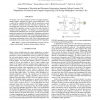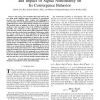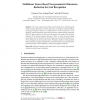57 search results - page 2 / 12 » Convergence and Rate of Convergence of a Manifold-Based Dime... |
ICASSP
2008
IEEE
13 years 10 months ago
2008
IEEE
We propose a new low complexity and fast converging frequencydomain adaptive algorithm for sparse system identification. This is achieved by exploiting the MMax and SP tap-select...
TSP
2010
12 years 11 months ago
2010
The strong cross-correlation that exists between the two input audio channels makes the problem of stereophonic acoustic echo cancellation (AEC) complex and challenging to solve. R...
FOCM
2010
13 years 2 months ago
2010
One of the most widely used methods for eigenvalue computation is the QR iteration with Wilkinson’s shift: here the shift s is the eigenvalue of the bottom 2 × 2 principal mino...
ICB
2009
Springer
13 years 11 months ago
2009
Springer
The small sample size problem and the difficulty in determining the optimal reduced dimension limit the application of subspace learning methods in the gait recognition domain. To...
JMLR
2010
12 years 11 months ago
2010
The goal of sufficient dimension reduction in supervised learning is to find the lowdimensional subspace of input features that is `sufficient' for predicting output values. ...



